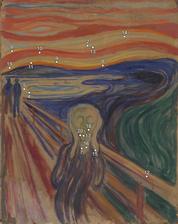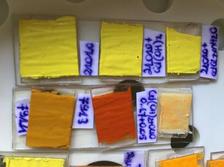Photo of the painting “The Scream” (Munch Museum, Oslo, Norway) showing the points where reflection and fluorescence spectroscopy analyses were performed.
The main factor causing the deterioration of the masterpiece “The Scream” by Edvard Munch is moisture. That is the conclusion, based on studies also at PETRA III, drawn by a team of scientists led by Letizia Monico from Italy and Koen Janssens from Belgium with other members from France, Germany, the United States and Brazil, who used a combination of different techniques to examine the work of art. The study has now been published in the scientific journal Science Advances. The results were obtained at a number of sites, including DESY’s PETRA III X-ray source, and could help to preserve this masterpiece, which is rarely exhibited due to its deterioration.
“The Scream” (1910) by the Norwegian Edvard Munch (1863-1944) is a world-famous painting, expressing human anguish and despair like few other works of art. Several versions of the painting exist, created by Munch over many years using different techniques – each version is unique in itself. Probably the most famous version of the painting, belonging to the Munch Museum in Oslo (Norway), was stolen in 2004 and was only recovered two years later, in a poor condition. Since then, the work has not been exhibited, but has instead been stored in an air-conditioned room in the museum. The lower left corner of the painting displays distinct signs of water damage, but on top of this some of the yellow paint is fading and crumbling, especially in the region of the sunset, the lake and the neck of the main figure.
The team of scientists examined the painting to find out more about the causes of this deterioration. They first examined the painting in the museum in Oslo using a combination of non-invasive spectroscopic methods. With the help of macroscopic X-ray fluorescence, they were able to show how chemical elements such as cadmium, mercury and chlorine are distributed across the entire surface of the painting. They discovered that some of the cadmium yellow paint is rich in chlorine compounds and that it is precisely in these areas that the paint has suffered damage.
The researchers went on to examine some tiny fragments of yellow paint that had come loose using high-intensity, narrowly focused synchrotron radiation, comparing these samples with artificially aged samples which they had made from original cadmium yellow pigment and a tube of cadmium yellow oil paint that had belonged to Munch. Their aim was to compare the data from the various pigments to determine what might be causing the chemical changes. These experiments were carried out at the European Synchrotron Radiation Facility ESRF and DESY’s X-ray source PETRA III. “With the X-ray microscope on the PETRA III beamline P06, powder diffraction can be used to image the distribution of cadmium compounds at a sub-micrometre resolution,” says DESY’s Gerald Falkenberg, who is in charge of the beamline and was also involved in the project.
The scientists discovered that bright yellow cadmium sulphide oxidises to become the colourless cadmium sulphate, which explains why the colour fades. This spontaneous transformation has already been observed in paintings by other famous artists from the same period, such as Vincent Van Gogh, James Ensor and Henri Matisse.
Such bleaching is usually attributed to the effects of light shining on the painting, by much the same process that converts sunlight into electricity in a solar cell. In the case of “The Scream”, however, the deterioration occurred mainly in areas where chlorine-rich cadmium yellow was present, but not in other parts of the painting, although all of them have been exposed to approximately the same amount of light. A different or an additional factor must therefore be responsible for the chemical reaction of the yellow paint.
Using artificial ageing experiments on cadmium yellow paint, which they made themselves and which contained either high or low levels of chlorine compounds, and by comparing light-induced ageing with ageing induced by heating the paint under humid conditions, the scientists were able to show that it is mainly the high humidity and not the incident light that is causing the yellow paint in “The Scream” to crumble and fade.
Based on the results of this study, the museum’s curators now want to ensure that in future “The Scream” will be stored under conditions of comparatively low relative humidity (45%) but normal light intensity so as to slow down or stop further aging as much as possible.
(from DESY News)
Reference:
Probing the chemistry of CdS paints in The Scream by in situ noninvasive spectroscopies and synchrotron radiation x-ray techniques, Letizia Monico, Laura Cartechini, Francesca Rosi, Annalisa Chieli, Chiara Grazia,Steven De Meyer, Gert Nuyts, Frederik Vanmeert, Koen Janssens, Marine Cotte,Wout De Nolf, Gerald Falkenberg, Irina Crina Anca Sandu, Eva Storevik Tveit, Jennifer Mass, Renato Pereira de Freitas, Aldo Romani, Costanza Miliani, Science Advances (2020), DOI: 10.1126/sciadv.aay3514








